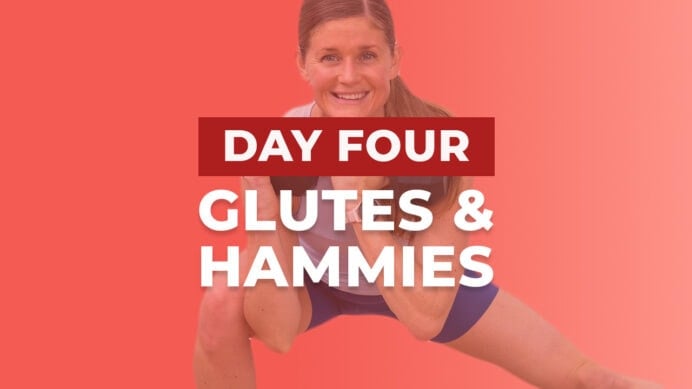
35-Minute Strength Building Workout
This strength-building workout is designed to improve functional movement, build lean muscle and increase overall strength using 7 compound exercises. It’s ideal for anyone looking to move better, feel stronger and support long-term fitness. Targeting major muscle groups, it helps with everyday performance, injury prevention and maintaining muscle as we age.
I’ve always advocated for strength training – and I don’t just mean lifting weights for aesthetics. I mean building real, functional strength that supports your body in everyday life. Strength-building workouts are all about challenging your muscles through resistance to improve your overall physical capability. Strength workouts are my favorite kind of training, especially right now. As I enter my late 30s, my goal is to put on as much muscle mass as possible so that I’m better equipped to handle perimenopause and menopause later on.
For me, the best workout routine to build strength includes compound exercises that engage multiple muscle groups at once. Think squats, deadlifts, push-ups, pull-ups and overhead presses. These movements mimic how our bodies naturally move, making them incredibly effective from a functional fitness standpoint. Not only do they help build muscle, but they also improve coordination, balance and joint stability, which are essential as we age or simply move through daily life.
When I build full-body workouts, I start with lower and upper body push movements, follow with lower and upper pulls, add lateral moves, target stabilizers and accessories, then finish with a powerful full-body exercise to bring it all together.
One question I get a lot is: What exercise builds the most strength? If I had to choose just one, I’d say the deadlift is a great option. It recruits muscles from head to toe – your glutes, hamstrings, back, core and grip strength. That said, a well-rounded hybrid program includes a variety of movements to target different areas and avoid imbalances.
A strength training routine is especially important for women, who have been discouraged from lifting heavy for too long. Building muscle doesn’t make you bulky; it makes you capable. Stronger muscles mean better posture, more energy, a faster metabolism and fewer injuries (Mayo Clinic). Plus, muscle loss starts around age 30, so the sooner we make resistance training a consistent habit, the better we age.
Whether your goal is to lose body fat, gain muscle, improve athletic performance or simply feel more confident and capable, strength training can get you there. It’s about showing up, pushing yourself and honoring what your body can do.
MEMBER SPOTLIGHT
MEET LINDSAY + LESLEY!
For more exclusive workout challenges, live workouts, nutrition chats, and direct support from our team, become a YouTube Member today.
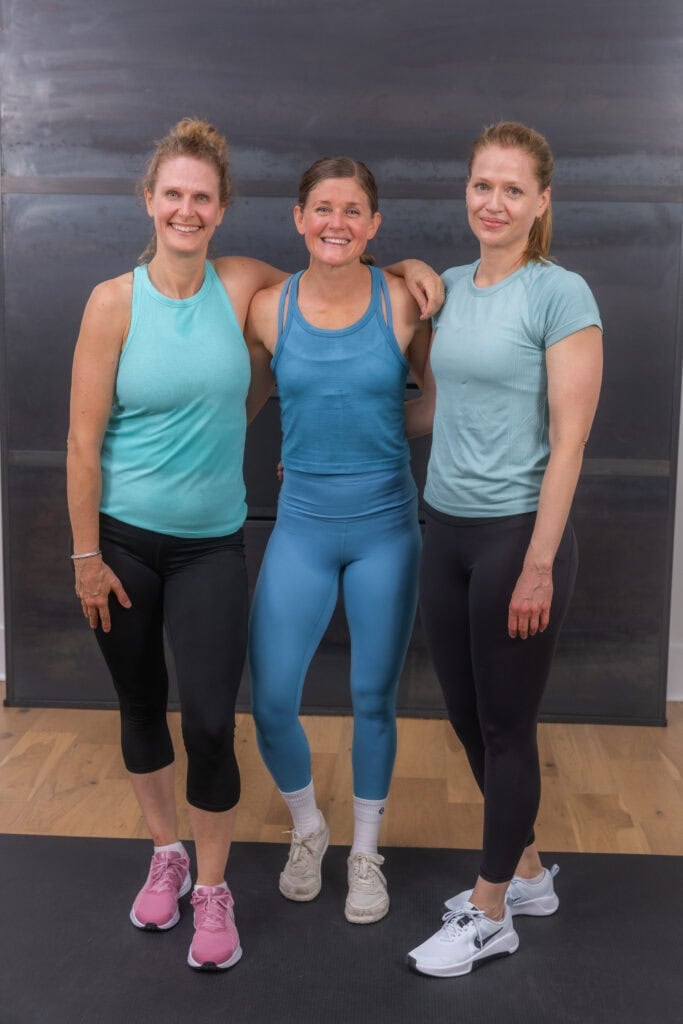
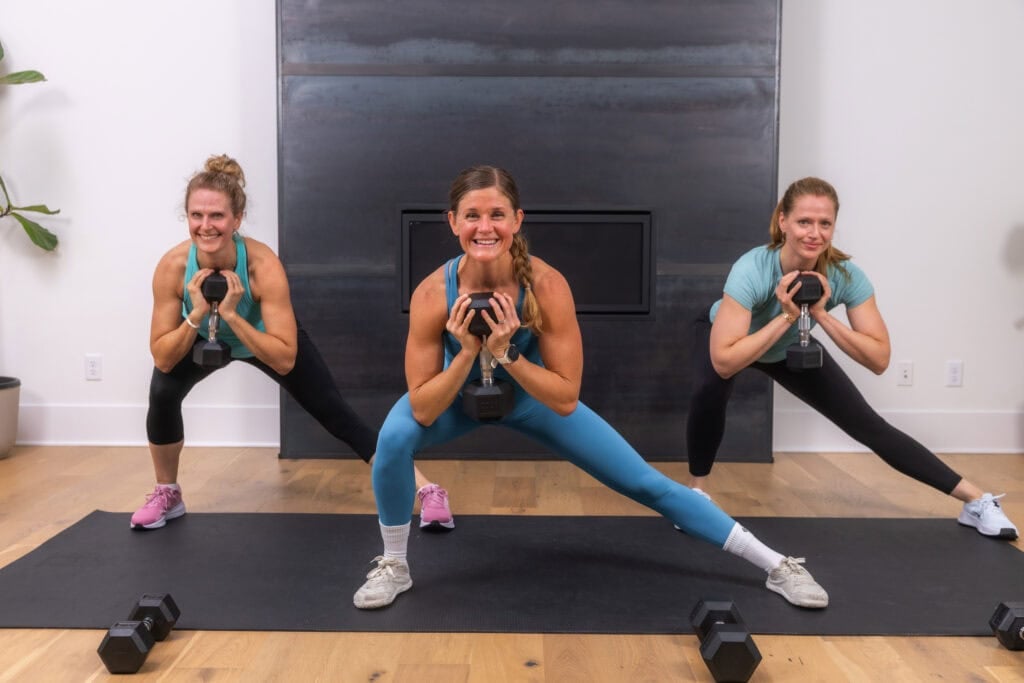
Workout Details
This 35-minute strength session is fast, functional and effective. Whether you’re a beginner or an experienced athlete, this workout can be scaled to meet your needs.
When it comes to how many sets you need to build muscle, I typically aim for 3-4 sets of 6-12 reps per exercise, depending on the goal. Lower reps (around 4-6) with heavier weights are ideal for maximal strength, while moderate reps (8-12) are great for muscle growth (hypertrophy). The key is consistency and progressive overload or gradually increasing the weight or reps over time.
I recommend 3-4 strength training sessions a week. This gives your muscles enough stimulus to grow and adapt while still allowing for proper recovery. Strength training doesn’t have to be long or complicated – 30-45 minutes of focused work can go a long way. Add full-body home workouts like this one to your training program 1-2 times a week.
Workout Equipment
Medium to Heavy Set of Dumbbells. I recommend between 5-25 lbs, depending on your fitness level. I’m using 20-30 lb dumbbells in today’s workout.
Workout Instructions
Follow along with the guided Full-Body Strength Workout on YouTube, led by me, your certified personal trainer, Lindsey Bomgren.
Your Workout Looks Like This:
- Guided Warm-Up and Cool-Down
- 7 Full-Body Exercises
- Timed Intervals (40-second work periods and 20-second rest periods. Perform as many repetitions as possible while maintaining good form during the timed intervals.)
- Repeat All 7 Exercises x3 Sets
- Ab Burnout to Finish
Workout Outline
1. Squat and Lunge
Targets: Lower body – glutes, quadriceps, hamstrings, hips and core.
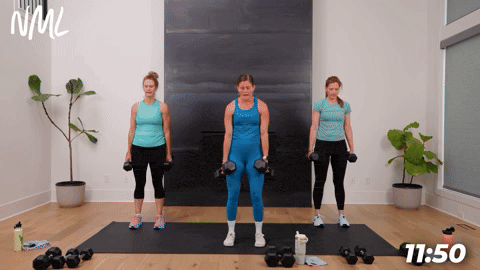
How to Do a Squat and Lunge
- Start standing feet shoulder-width apart and knees slightly bent, holding a pair of dumbbells at your sides.
- Lower down into a squat position, lowering your hips down parallel with your knees. Drive your knees out toward your outer toes.
- Drive through your heels to stand tall, returning to a standing position.
- Step your right foot back into a reverse lunge. Lower your right knee towards the mat, aiming for 90-degree angles in both knees.
- Hold for a moment, then drive through your front, left heel to return to standing.
- Repeat the dumbbell squat, then alternate the lunge, this time stepping your left foot back into a reverse lunge.
Modification: If squats and lunges are uncomfortable, check out these alternative exercises.
2. Shoulder Press
Targets: Shoulders, triceps, rear delts and upper back muscles.
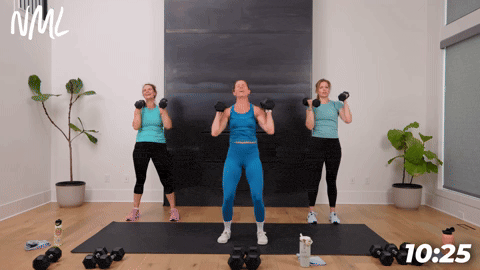
How to Do a Shoulder Press
- Stand with your feet shoulder-width apart and knees slightly bent. Hold a pair of dumbbells at shoulder height, palms facing in towards each other (neutral grip). Your shoulder blades are pulled back and down.
- Engage your core, slightly tucking your pelvis to protect your lower back. Push the dumbbell in your right hand overhead until your right arm is fully extended.
- Lower the dumbbell to shoulder height, returning to the starting position.
- Push the dumbbell in your left hand overhead until your left arm is fully extended.
- Lower the dumbbell to shoulder height, returning to the starting position.
- Finally, push both dumbbells overhead until arms are fully extended, locking out your biceps near your ears.
- Lower the dumbbells to shoulder height, returning to the starting position.
3. Staggered Deadlift
Targets: Legs, glutes, hamstrings, hips, lower back and core.
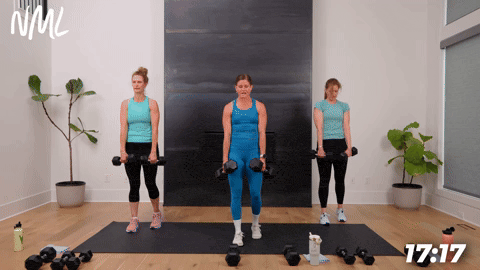
How to Do a Staggered Deadlift
- Stand with your feet hip-width apart, knees slightly bent. Hold a pair of dumbbells at your hips, palms facing in towards your body.
- Stagger your feet, so your left leg is slightly in front of your right foot. Kickstand your back right foot, right heel floating off the ground. Keep 80% of your weight in your front foot, 20% in your back right toes.
- Maintain a staggered stance as you hinge at the hips. Push your hips back towards the wall behind you as you glide the dumbbells down the front of your legs. Keep your core tight and engaged.
- Drive through your front left heel to push your hips forward, pulling the dumbbells back up towards your hips as you stand tall.
4. Single-Arm Back Row
Targets: Mainly the latissimus dorsi (or lats; the largest back muscle), biceps and core.
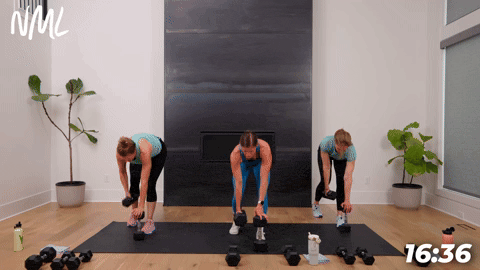
How to Do a Single-Arm Back Row
- Stand with your feet shoulder-width distance apart. Hold one dumbbell in your left hand, palm facing your midline. Place your right dumbbell on the ground in front of you, resting your right fingertips gently on the head of the dumbbell.
- Hinge at the hips until your torso is parallel to the floor (neck in line with your spine, flat back, belly pulled in).
- Hold this position as you perform a single-arm row on the left side. Pull the dumbbell in your left hand back towards your left hip, squeezing your back muscles as you perform the movement.
- Control the dumbbell back down to the starting position and repeat.
5. Lateral Squat
Targets: Gluteus medius (outer glute that controls hip movement and side-to-side movements), quads, inner thighs (or hip adductors), hamstrings and calves.
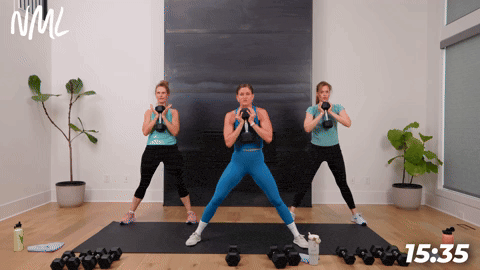
How to Do a Lateral Squat
- Start with your feet wider than your hips (think a wide squat stance). Your knees and toes are either pointing forward or your toes are just slightly turned out away from your body. Hold one dumbbell at your chest in a goblet squat hold.
- Shift your weight into your left heel as you push your hips back, bending your left knee while leaving your right leg straight. Think of performing a single-leg squat with your left leg while your right leg remains straight.
- Drive through your left foot to reverse the movement, pushing you back to center.
- Repeat, this time shifting your weight into your right heel as you push your hips back, bending your right knee while leaving your left leg straight.
6. Single Leg Glute Bridge and Skull Crushers
Targets: Legs, glutes, hamstrings, inner thighs, triceps and core.
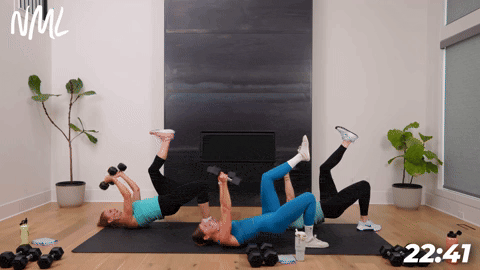
How to Do a Single Leg Glute Bridge and Skull Crusher
- Start lying on your back, right foot planted flat on the ground, left foot extended overhead. Hold a pair of dumbbells in your hands, wrists stacked over your shoulders, palms facing in towards each other.
- Press through your heel to lift your glutes off the mat, squeezing your glutes as you lift. Think about keeping your core engaged and knees in line with your hips. Hold this single-leg glute bridge.
- Bend at the elbows to slowly lower the dumbbell towards your head, performing a skull crusher.
- Then, squeeze the back of your arm to straighten your elbows, pressing the dumbbells back overhead.
- Slowly lower your hips towards the mat, hovering an inch above the ground, returning to the starting position.
Modification: Perform a standard double-leg glute bridge rather than a single-leg glute bridge.
7. Dumbbell Burpee With Stack on Push-Ups
Targets: Legs, glutes, hamstrings, hips, calves, chest, triceps, shoulders and core.
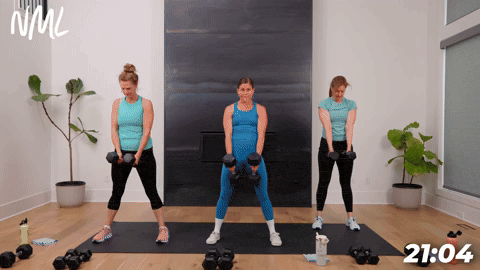
How to Do a Dumbbell Burpee With Stack on Push-Ups
- Stand with feet hip-distance apart or a little wider. Hold a dumbbell in each hand in front of your hips.
- Engage your core and lower your hips down to the bottom of a squat as you place the dumbbells on the ground between your feet.
- Step or jump both feet back to a high plank position. Make a straight line with your body from head to feet.
- Perform a controlled push-up, lowering your chest toward the ground as your elbows track back close to your body.
- Pause for a moment, then in one explosive movement, jump both feet forward and land in a low squat just outside your dumbbells.
- Explosively stand up, pulling the dumbbells up the front of your legs as you return to the starting position.
- Note that in this variation, we will “stack-on” the number of push-ups we perform. Start with 1 push-up, then perform 2, then 3 and so on.
Modification: Push-ups are an extremely effective bodyweight exercise to build strength, but if you can’t do them on your toes, you can substitute one of these push-up modifications. If push-ups hurt your wrists, substitute one of these exercises for wrist pain.
FAQs
The “Big 5” exercises for strength training are typically squats, deadlifts, bench presses, overhead presses, and pull-ups. These compound exercises engage multiple muscle groups at once, so they’re extremely effective in building total-body strength. Lift heavy and challenge your rep max in order to increase strength.
Ultimately, how often you change your strength training routine will depend on your training intensity and goals. Generally, changing your strength training routine every 4-6 weeks is a good guideline. Beginners may benefit from sticking to the same routine for 6-12 weeks. More advanced lifters who are chasing strength gains might need to switch things up every 3-4 weeks. Pay attention to how your body responds to exercises and adjust your weightlifting routine as needed.
Again, whether you should do cardio or weights first depends on your personal fitness goals. If muscle building is your goal, you should lift weights first. If you are a runner who is training for a specific race or wants to improve your endurance, conditioning or cardiovascular fitness, you should prioritize aerobic exercise and do cardio first.
Popular strength training programs include a push/pull/legs workout split and progressive overload training splits. If you are new to weight training, I’d recommend starting with a beginner workout plan or a functional strength training workout plan.
More Workouts
Strength TrainingPin This 35-Minute Strength Building Workout

This post includes affiliate links. I do earn a commission for products purchased using these links (at no additional cost to you). Thank you for supporting Nourish Move Love, making the content you see on this blog possible.










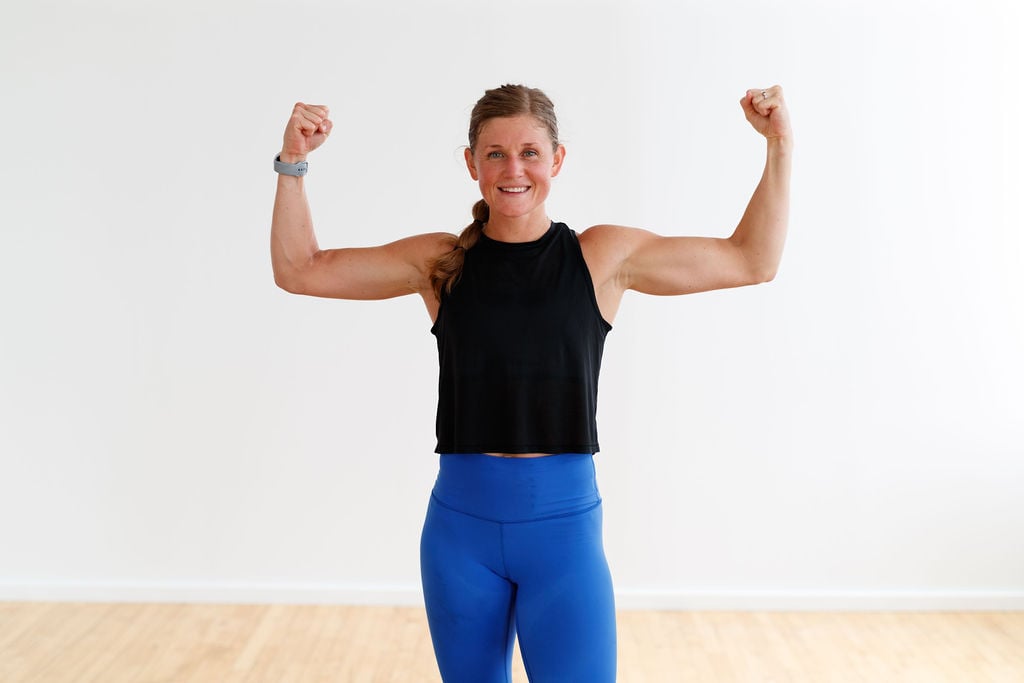
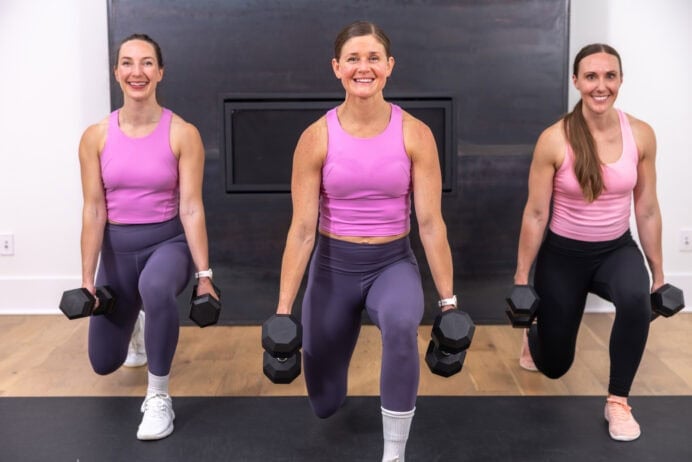
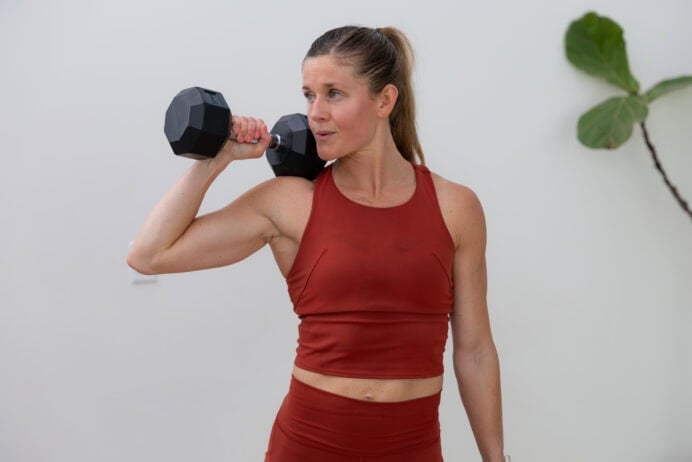
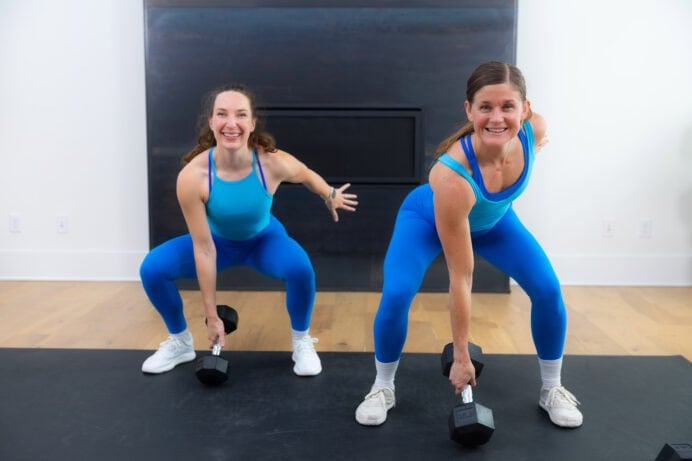
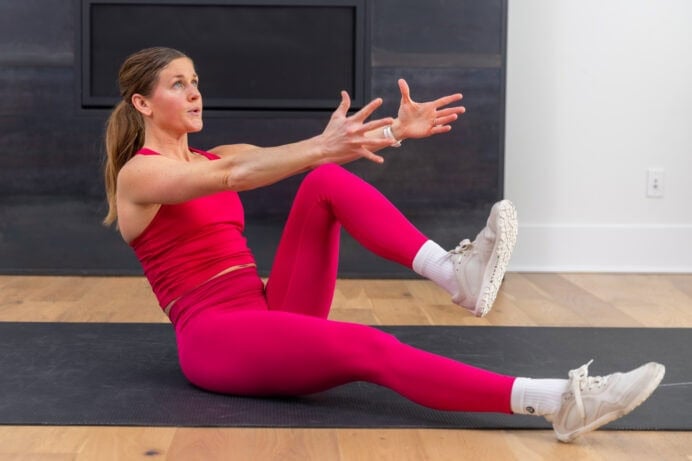
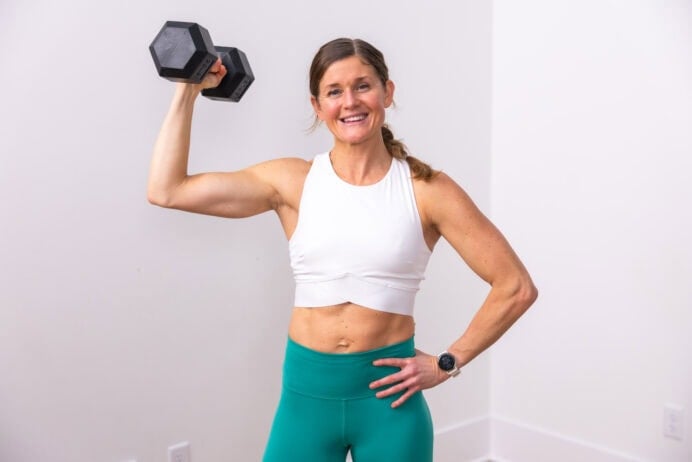
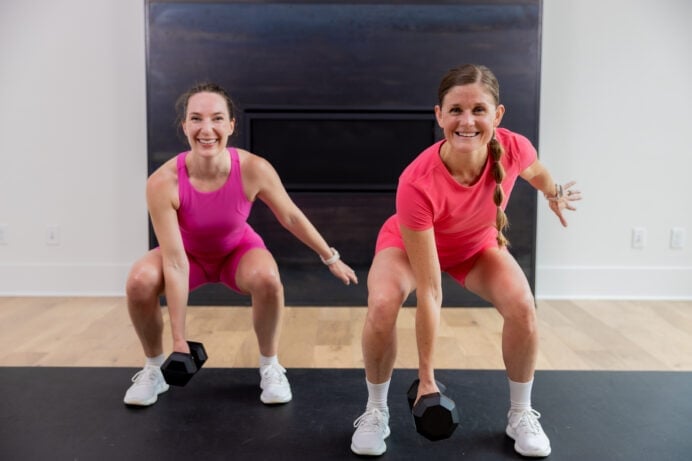
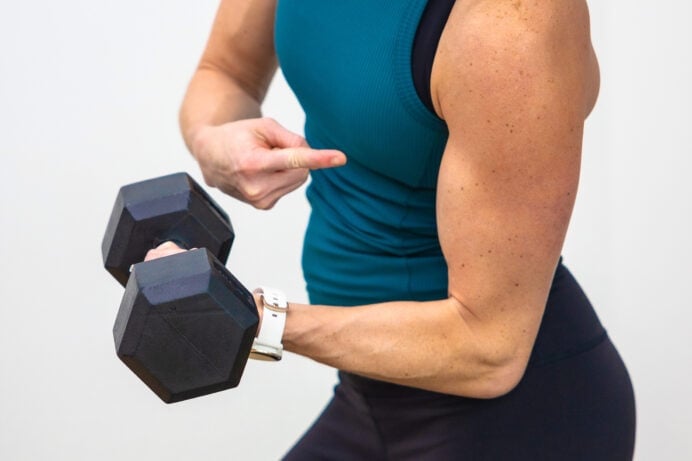
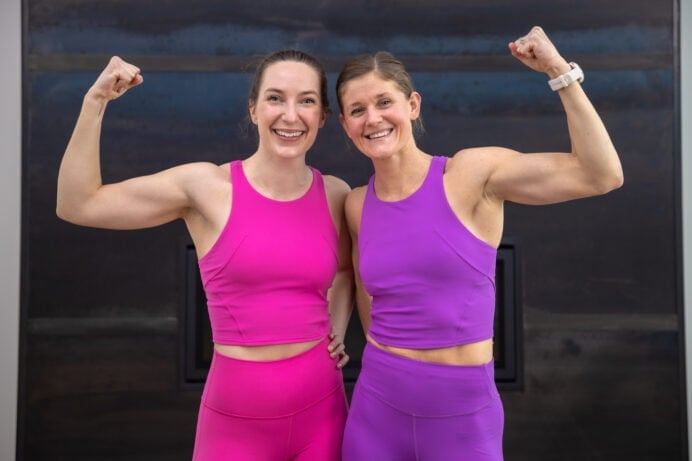
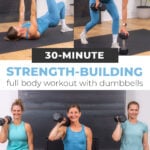
Loved it – such a killer workout. Left me in a puddle of sweat.
Thanks for trying this one, Blue! Keep up the awesome work! -Lindsey
It was great! I did this without the video since my little girl was asleep in my bed. The written form was excellent! Thank you Lindsey and team!!
Hi Kathryn! I am so glad you enjoyed this workout. Thanks for trying it today! -Lindsey